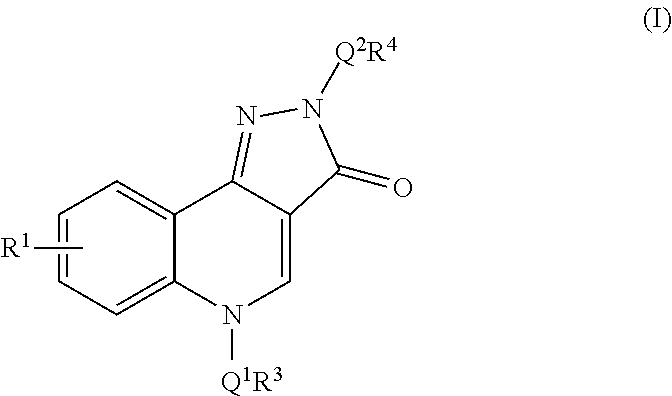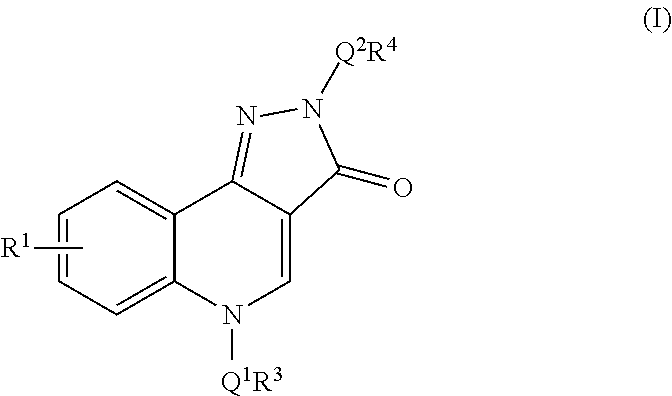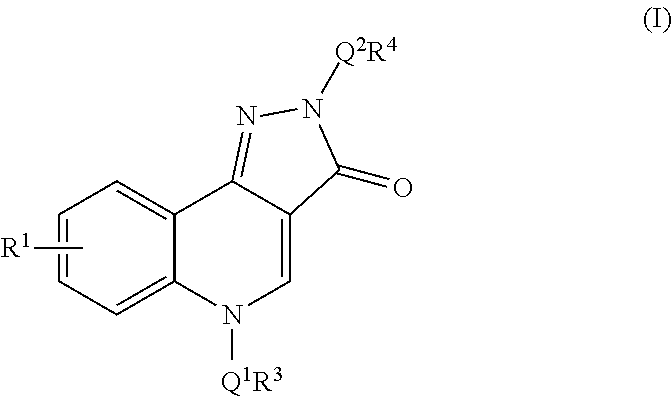Quinolinone-pyrazolone m1 receptor positive allosteric modulators
a technology of allosteric modulators and quinolinones, which is applied in the field of quinolinonepyrazolone compounds, can solve the problems of behavior deficits, progressive memory impairment, and loss of language and visuospatial skills, and therapy has not been shown to change the underlying disease pathology
- Summary
- Abstract
- Description
- Claims
- Application Information
AI Technical Summary
Benefits of technology
Problems solved by technology
Method used
Image
Examples
example 1
2-(2-Fluorophenyl)-5-{[4-(methoxy)phenyl]methyl}-2,5-dihydro-3H-pyrazolo[4,3-c]quinolin-3-one
[0389]
[0390]Step 1: Preparation of ethyl {[4-(methoxy)phenyl]methyl}-4-oxo-1,4-dihydroquinoline-3-carboxylate: Ethyl 4-oxo-1,4-dihydroquinoline-3-carboxylate (3.17 g, 14.6 mmol) and 4-methoxybenzylchloride (2.18 mL, 16.0 mmol, 1.1 equiv) were combined in N,N-dimethylformamide (50 mL) and stirred at ambient temperature for 72 hours. The mixture was poured into water (500 mL) and extracted with dichloromethane (2×250 mL). The combined organic extracts were dried with sodium sulfate, filtered and concentrated in vacuo. The residue was treated with water (500 mL), hexanes (500 mL) and ethyl acetate (500 mL) and aged for 30 minutes. The mixture was filtered and the solid was dissolved in dichloromethane (500 mL) and combined with the filtrate. The filtrate was partitioned and the aqueous layer was discarded. The organic layer was dried with sodium sulfate, filtered and concentrated in vacuo, prov...
example 8
2-(2-Fluorophenyl)-5-(biphenyl-4-ylmethyl)-2,5-dihydro-3H-pyrazolo[4,3-c]quinolin-3-one
[0394]
[0395]Step 1: Preparation of ethyl 1-(biphenyl-4-ylmethyl)-4-oxo-1,4-dihydroquinoline-3-carboxylate: Ethyl 4-oxo-1,4-dihydroquinoline-3-carboxylate (6.11 g, 28.1 mmol), 4-(bromomethyl)biphenyl (9.04 g, 36.6 mmol, 1.3 equiv), potassium iodide (467 mg, 2.81 mmol, 0.1 equiv) and potassium carbonate (9.72 g, 70.3 mmol, 2.5 equiv) were combined in N,N-dimethylformamide (10 mL) and stirred at ambient temperature for 18 hours. The mixture was poured into water (100 mL) and ethyl acetate (100 mL) and aged for 2 hours. The mixture was filtered, the filtrate discarded and the solid was dissolved in dichloromethane (100 mL), dried with sodium sulfate, filtered and concentrated in vacuo, providing the titled compound.
[0396]Step 2: Preparation of ethyl 1-(biphenyl-4-ylmethyl)-4-thioxo-1,4-dihydroquinoline-3-carboxylate: Ethyl 1-(biphenyl-4-ylmethyl)-4-oxo-1,4-dihydroquinoline-3-carboxylate (474 mg, 1.24 ...
example 22
5-(Biphenyl-4-ylmethyl)-2-phenyl-2,5-dihydro-3H-pyrazolo[4,3-c]quinolin-3-one
[0400]
[0401]Ethyl 1-(biphenyl-4-ylmethyl)-4-thioxo-1,4-dihydroquinoline-3-carboxylate [(Example 8, Step 2), 72 mg, 0.18 mmol] and phenylhydrazine (0.19 g, 1.8 mmol, 10 equiv) were combined in absolute ethanol (5 mL) and placed into a preheated oil bath at 75° C. for 18 hours. The mixture was cooled to ambient temperature and concentrated in vacuo. The residue was dissolved in dichloromethane (10 mL) and treated with di-tert-butyldicarbonate (0.30 g, 1.4 mmol, 7.8 equiv). After stirring for 5 hours at ambient temperature, the mixture was concentrated in vacuo and the residue was purified by silica gel gradient chromatography (100:0 to 95:5; dichloromethane:methanol), providing the titled compound: 1H-NMR (500 MHz, d6-DMSO) δ 9.17 (1H, s), 8.31 (1H, dd, J=7.8, 1.4 Hz), 8.22 (2H, d, J=7.6 Hz), 7.81 (1H, d, J=8.8 Hz), 7.67-7.62 (5H, m), 7.57 (1H, t, J=7.8 Hz), 7.48-7.40 (6H, m), 7.35 (1H, t, J=7.4 Hz), 7.20 (1H...
PUM
| Property | Measurement | Unit |
|---|---|---|
| Temperature | aaaaa | aaaaa |
| Temperature | aaaaa | aaaaa |
| Temperature | aaaaa | aaaaa |
Abstract
Description
Claims
Application Information
 Login to View More
Login to View More - R&D
- Intellectual Property
- Life Sciences
- Materials
- Tech Scout
- Unparalleled Data Quality
- Higher Quality Content
- 60% Fewer Hallucinations
Browse by: Latest US Patents, China's latest patents, Technical Efficacy Thesaurus, Application Domain, Technology Topic, Popular Technical Reports.
© 2025 PatSnap. All rights reserved.Legal|Privacy policy|Modern Slavery Act Transparency Statement|Sitemap|About US| Contact US: help@patsnap.com



